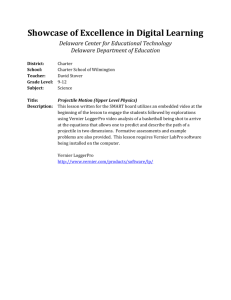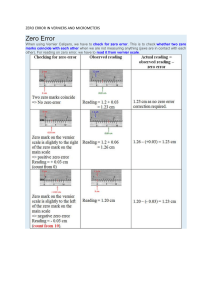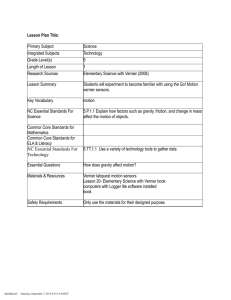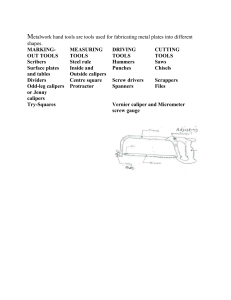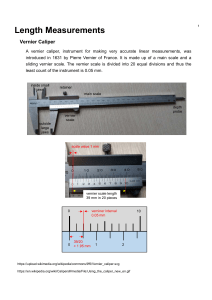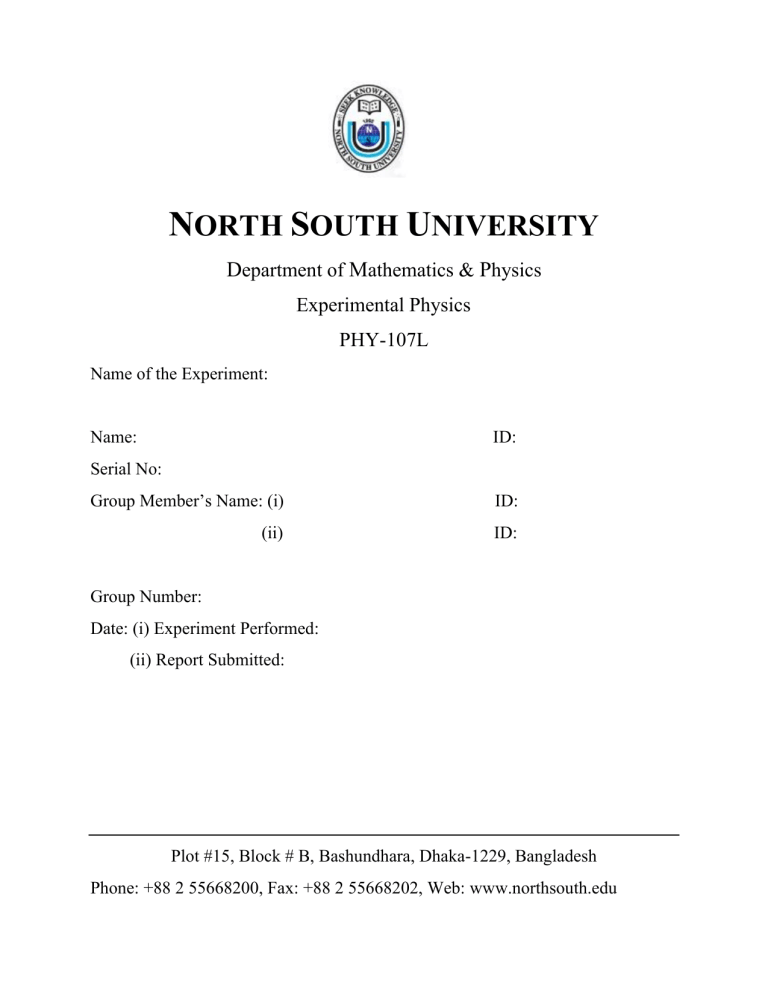
NORTH SOUTH UNIVERSITY Department of Mathematics & Physics Experimental Physics PHY-107L Name of the Experiment: Name: ID: Serial No: Group Member’s Name: (i) ID: (ii) ID: Group Number: Date: (i) Experiment Performed: (ii) Report Submitted: Plot #15, Block # B, Bashundhara, Dhaka-1229, Bangladesh Phone: +88 2 55668200, Fax: +88 2 55668202, Web: www.northsouth.edu Expt-1: Introduction to Measurement and Statistical Error Objective: 1. To familiarize the student with random error and bias in laboratory measurements (ruler, Vernier caliper, screw gauge). 2. To introduce the concepts of arithmetic mean, standard deviation and experimental error. Apparatus: Vernier caliper, screw gauge, centimeter ruler, a small cylinder. Theory: Measurement of different shapes: The Vernier Caliper The Vernier caliper is designed to facilitate the estimation of a fractional part of a scale or ruler. The Vernier consists of an auxiliary scale, called the Vernier scale, which is capable of sliding along the edge of a main scale (Figure 1). With the help of the Vernier scale, length can be measured with an accuracy greater than that obtainable from the main scale. The graduations on the Vernier scale are such that n divisions of this scale are generally made to coincide with (𝑛 – 1) divisions of the main scale. Under this condition, lengths 1 can be measured with an accuracy of 𝑛 of the main scale division. Figure 1: Parts of Vernier Caliper For example, in the following figure ten units of the Vernier scale have the same length as nine units of the main scale. Each unit on the Vernier scale is therefore 1/10 mm smaller than the smallest unit of the main scale. Thus, the line on the Vernier which is aligned with a line on the main scale indicates the number of tenths of a millimeter that the index is past the last whole millimeter of the main scale. The index in Figure 1 is located to the right of 3.2 centimeters. Hence, the reading is a little more than 3.2 centimeters, but not as large as 3.3 centimeters. The line indicating the third unit of the Vernier scale is directly beneath a line on the main scale. It is the fifth line on the Vernier scale that lines up. This tells us that the reading is 3.25 centimeters .2 0 1 2 3 4 .05 3 Measured Value: 3.25 cm Figure 2: How to Read a Vernier Caliper. An instrumental error or zero error exists when, with the two jaws touching each other, the zero of the Vernier scale is ahead of or behind the zero of the main scale. The error is positive when the Vernier zero is on the right and is negative when the Vernier zero is cm the left side of the main scale zero. If the instrumental error is positive it is to be subtracted from the measured length to obtain the correct length. If the error in negative is to be added to the measured length. The Screw Gauge It consists of a U-shaped piece of steel, one arm of which carries a fixed stud and the other arm is attached to a cylindrical tube. A scale graduated in centimeters or inches is marked on this cylinder. An accurate screw provided with a collar, moves inside the tube. The screw moves axially when it is rotated by the milled head. The fixed and the movable studs are provided with jaws (plane surfaces). The principle of the instrument is the conversion of the circular motion of the screw head into the linear motion of the movable stud. Figure 3: Screw gauge and measuring a shape. The beveled end of the rotating barrel is generally divided into 50 or 100 equal divisions forming a circular scale. Depending upon the direction of rotation of the screw the collar covers or uncovers the straight scale divisions. When the movable stud is made to touch the fixed stud, the zero of the linear (straight) scale should coincide with the zero of the circular scale. If they do not coincide then the screw gauge is said to possess an instrumental error. The pitch of the screw is defined as its axial displacement for a complete rotation. The least count (L.C.) of the screw gauge refers to the axial displacement of the screw for a rotation of one circular division. Thus, if n represents the number of divisions on the circular scale and the pitch of the screw is m scale divisions, 𝑚 then the least count (L.C.) of the screw gauge = 𝑛 scale divisions. Back-lash error: When a screw moves through a threaded hole there is always some misfit between the two. As a result, when the direction of rotation of the screw is reversed, axial motion of the screw takes place only after the screw head is rotated through a certain angle. This lag between the axial and the circular motion of the screw head is termed the back-lash error. In order to get rid of this error, the screw head should always be rotated in the same direction while measurement is made. Experimental Error: Accuracy is the degree to which a measurement agrees with an accepted value for those measurements. The accuracy of a measurement is dependent upon the production and calibration of the instrument. When an instrument is calibrated according to a reliable standard then measurement will be more closely aligned with the accepted value for that measurement. Measurement can be evaluated in absolute or relative terms. The absolute error is the absolute value of the difference between the accepted value and the measurement. This can be written as an equation as shown below. Absolute error = |Observed value - Accepted known value| Ea = |O - A| (1i) This can be expressed as a percentage error also as: 𝐸𝑎 = |𝑂−𝐴| 𝐴 × 100% (1ii) Data can also be evaluated in terms of how measurements, which are made in the same manner, deviate from one another. The deviation of experimental data is dependent upon the reproducibility with which the experimenter can take data. This is known as precision and is evaluated in terms of absolute and relative deviation. Absolute deviation is the absolute value of the difference between the mean or average value and the measured value. This is expressed below in the equation. Absolute deviation = |Observed value - Mean value| Da = |O - M| (2i) Another way to express the deviation is as a percentage. This is the relative deviation and is expressed as follows. Relative deviation = Average absolute deviation × 100% Dr = Da × 100% (2ii) Statistically the uncertainty of a measurement can be determined using a quantity called the standard deviation, σ. The standard deviation for a sample of N measurements is defined as follows: 1 ∑𝑁 (𝑥 𝑁−1 𝑖=1 𝑖 𝜎=√ where 𝑥̅ = ∑𝑁 𝑖=1 𝑥𝑖 𝑁 − 𝑥̅ )2 (3i) , N is the number of observation and xi each observation. The standard deviation is a measure of spread. If the standard deviation is small, then the spread in the measured values about the mean is small, and so the uncertainty is low but the precision in the measurements is high. The standard deviation is always positive and has the same units as the measured values. Therefore, the measured value of X can be written as: 𝑋 = 𝑋̅ ± 𝜎𝑋 . Standard error SE: one can measure the standard error of the measurement using the relation: 𝑆𝐸 = 𝜎 √𝑁 The standard error is smaller than the standard deviation by a factor of (3ii) 1 , √𝑁 this reflects the fact that we expect the uncertainty of the average value to get smaller when we use a larger number of measurements, N. Graphical interpretation of the standard deviation in normal distribution Suppose, N number of trials has been taken to measure the value of X. If you now make one more measurement, you can reasonably expect with about 68% confidence that the new measurement will be within one standard deviation of the mean value 𝑥̅ ± 1𝜎, 95% of the readings will be in the interval two standard deviations of the mean value 𝑥̅ ± 2𝜎, and nearly all (99.7%) of readings will lie within three standard deviations from the mean, 𝑥̅ ± 3𝜎. So, for example, if an experimental data point lies 3𝜎 from prediction, there is a strong chance that either the prediction is not correct or there are systematic errors which affect the experiment. The distribution of values symmetric with respect to the mean the so called “normal” distribution, or bellshaped curve. Schematically shown below: Propagation of Error Suppose A and B are two physical quantities with standard deviations σA and σB respectively. Let F defines a new physical variable that is determined by F = f(A,B). Using statistical analysis, the average value and the standard deviation of F can be calculated as follows: If F = f(A,B) = A ± B, corresponding mean value and the standard deviation are given by 𝐹 = 𝐴̅ ∓ 𝐵̅ (4) 𝜎𝐹 = √𝜎𝐴2 + 𝜎𝐵2 (5) If F = f(A,B,C) = ABC, corresponding mean value and the standard deviation are given by 𝐹 = 𝐴̅ × 𝐵̅ × 𝐶̅ 𝜎 (6) 𝜎 𝜎 𝜎𝐹 = |𝐹| × √( 𝐴𝐴̅ )2 + ( 𝐵̅𝐵 )2 + ( 𝐶𝐶̅ )2 (7) Significant Figures According to the discussion in the previous sections, it is clear that the accuracy of the measurement depends on the number of trials in addition to other factors. The question is how many digits we need to keep in a calculation or measurement. There is no fixed answer, however, more digits means better accuracy. As for example, the numbers 2, 2.0, 2.00, looks same. But 2.00 has better accuracy than 2. This feature is expressed by the notion of significant figures. The rule to find the significant figures in a number is the following: express the number in the scientific form abcd... = a.bcd... × 10d , where a,b,c,d etc are digits (i.e., 0,1,2,3, ...). The number of nonzero digits before the exponential factor is called the significant figure. That is, 2 is a one significant number, 2.0 a two significant number, 2.00 a three significant number, and so on. Similarly 2.05, 0.00375, 9.11 × 10−11 are all three significant numbers. Procedure: 1. Measure the length and diameter of the cylindrical rod using your ruler. Use eyeball guessing to approximate the value when necessary. Record the values in Table-1. 2. Before using the Vernier Ruler, find the Vernier constant using the formula: Vernier constant = 𝑉𝑎𝑙𝑢𝑒 𝑜𝑓 𝑡ℎ𝑒 𝑠𝑚𝑎𝑙𝑙𝑒𝑠𝑡 𝑑𝑖𝑣𝑖𝑠𝑖𝑜𝑛 𝑖𝑛 𝑡ℎ𝑒 𝑀𝑎𝑖𝑛 𝑆𝑐𝑎𝑙𝑒 𝑇𝑜𝑡𝑎𝑙 𝑛𝑢𝑚𝑏𝑒𝑟 𝑜𝑓 𝑑𝑖𝑣𝑖𝑠𝑖𝑜𝑛𝑠 𝑖𝑛 𝑡ℎ𝑒 𝑉𝑒𝑟𝑛𝑖𝑒𝑟 𝑆𝑐𝑎𝑙𝑒 3. Find the length of the cylinder using the Vernier scale and record in Table-2, each data will be calculated using the formula: Vernier scale reading = Main scale reading + Vernier Scale division × Vernier constant 5. Measure the length of the cylinder by putting in between the jaws of the Vernier scale. Read the main scale and Vernier scale readings, and record these in the Table-2. Use eyeball guessing to approximate the value when necessary. Compute the total reading using the formula given in the previous step. 6. Compute the average length and using Eq.(2), compute the standard deviation of the length measurement (or simply called error in measurement), and write it in the Table-2. 7. Before using the screw gauge find out the pitch (the distance along the linear scale traveled by circular scale when it is completed one rotation) and the total number of divisions of the circular scale of the screw gauge and calculate least count (L.C) using the formula: Least Count = Pitch (m) Total number of divisions in the circular scale (n) 8. Now measure the diameter of the cylinder, by setting in between the studs of the screw gauge. Read the linear scale and circular scale readings, use the expression below, find out the diameter of the cylinder and record these in the Table-3. Screw gauge reading = Linear scale reading + Circular scale division × Least count **Note: -Please carefully consider the instrumental error. You should add or subtract accordingly where needed. -In order to get rid of the backlash error, the screw head should always be rotated in the same direction while measurement is made. Data Tables: Table 1: Ruler measurements Data No. Length, L (cm) Radius, R (cm) 𝐿̅ (cm) 𝑅̅ (cm) 1 2 3 4 5 6 Table 2: Finding Length using Vernier Scale Vernier constant: _____________________ cm Data No. Main Scale reading (cm) Vernier scale division, d Length (cm) 1 2 3 4 5 6 Table-3: Data for the radius of the cylinder 𝐿̅ (cm) (𝐿̅ − 𝐿𝑖 )2 (cm2) 𝜎𝐿 (cm) Least count, LC= ________cm Instrumental error (if any) = _______________ cm Linear Data 1 2 3 4 5 6 scale reading, Circular scale reading, x y = d × Lc (cm) (cm) Diameter x+y (cm) Instrume ntal error (cm) Radius, Corrected diameter, D (cm) r= D 2 (cm) Mean radius, 𝑟̅ (𝑟̅ − 𝑟𝑖 )2 (cm) 𝜎𝑟 (𝑐𝑚2 ) (cm) Calculation for Volume and its error: Volume of a cylinder = 𝛑𝒓𝟐 𝒍 1. Using the ordinary ruler: Volume of the cylindrical rod, V1 = 2. Using the Vernier scale and screw gauge: Volume of the cylinder, V2 = 3. Error in volume calculation from Vernier ruler and screw gauge measurement (use propagation of error, equations 6,7), σV = 4. Final result, V2 ± σV = Result: Discussions:
